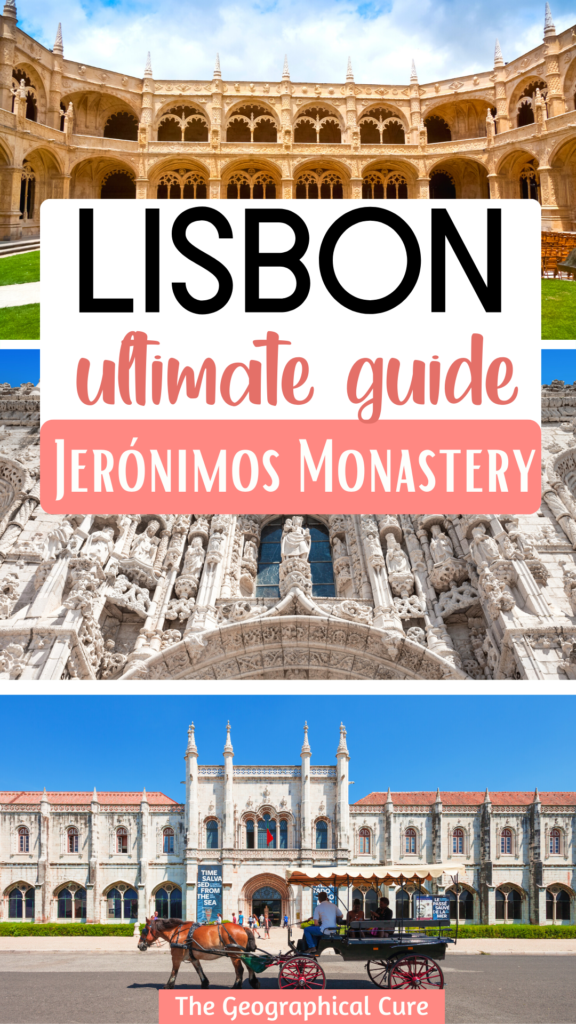Jeronimos Monastery is Portugal’s most visited heritage site. It’s a stunning testament to Portugal’s Age of Discoveries and a magnificent example of Manueline architecture.
The monastery is a twisting mass of honey colored stone that glows like gold in the sunshine. There’s also a marble esplanade dotted with gardens and fountains.
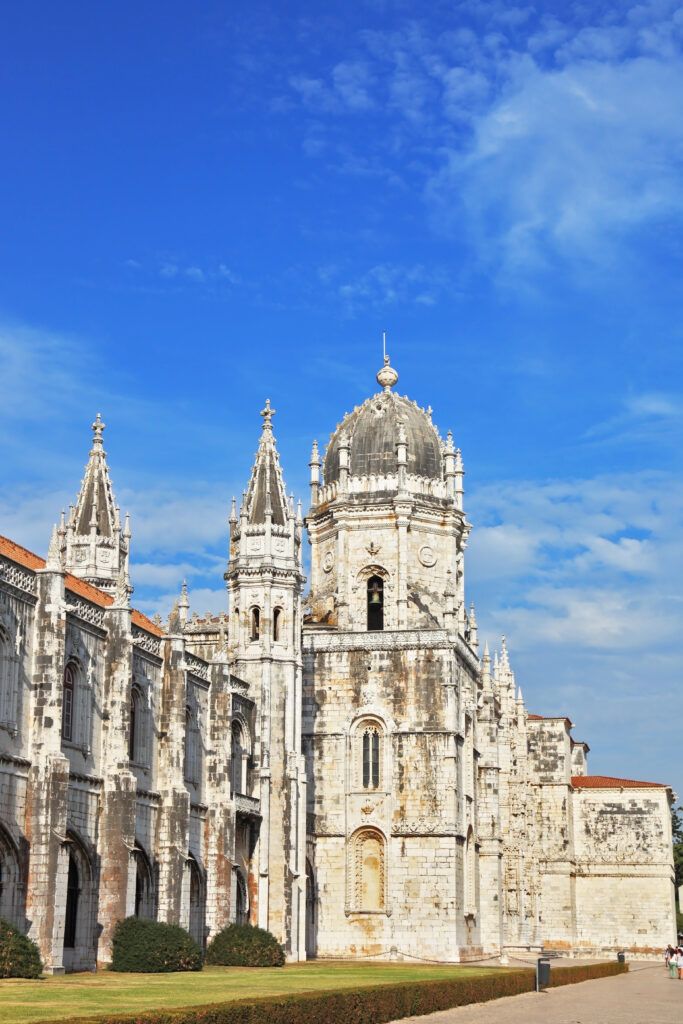
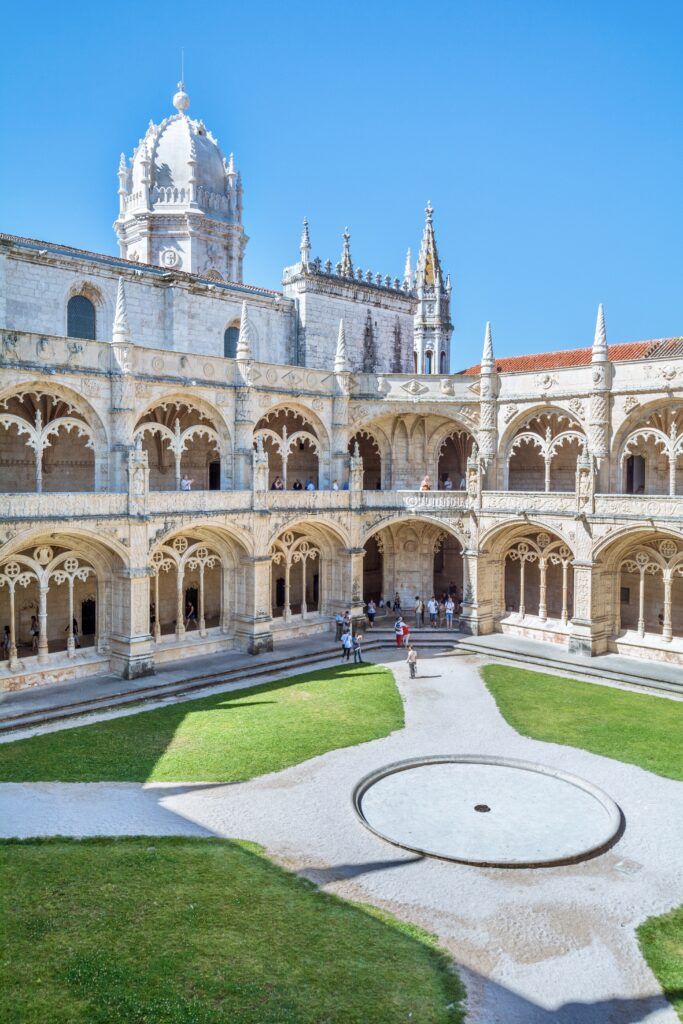
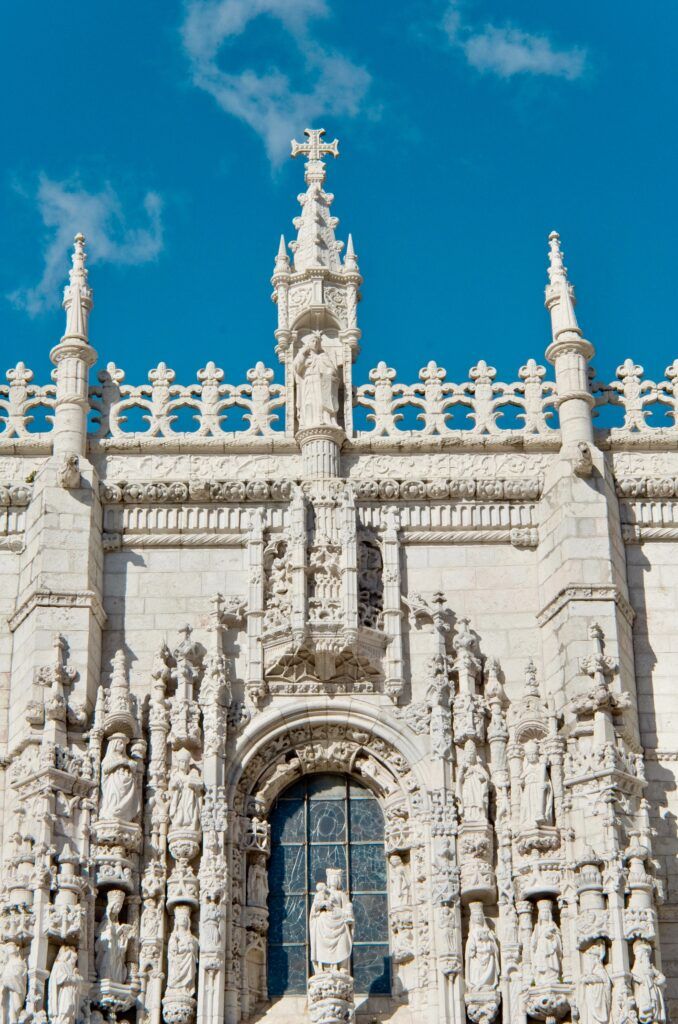
In this guide, I give you an overview of the monastery’s history, tell you everything to see inside this ornate shrine to Manueline architecture, and give you must know tips for visiting.
You can expect to see:
- church
- cloisters
- refectory
- chapter room
- monks’ dormitory
- archaeological museum
Let’s take a quick look at the history of this great monument and architectural style, to better prepare you for your visit.
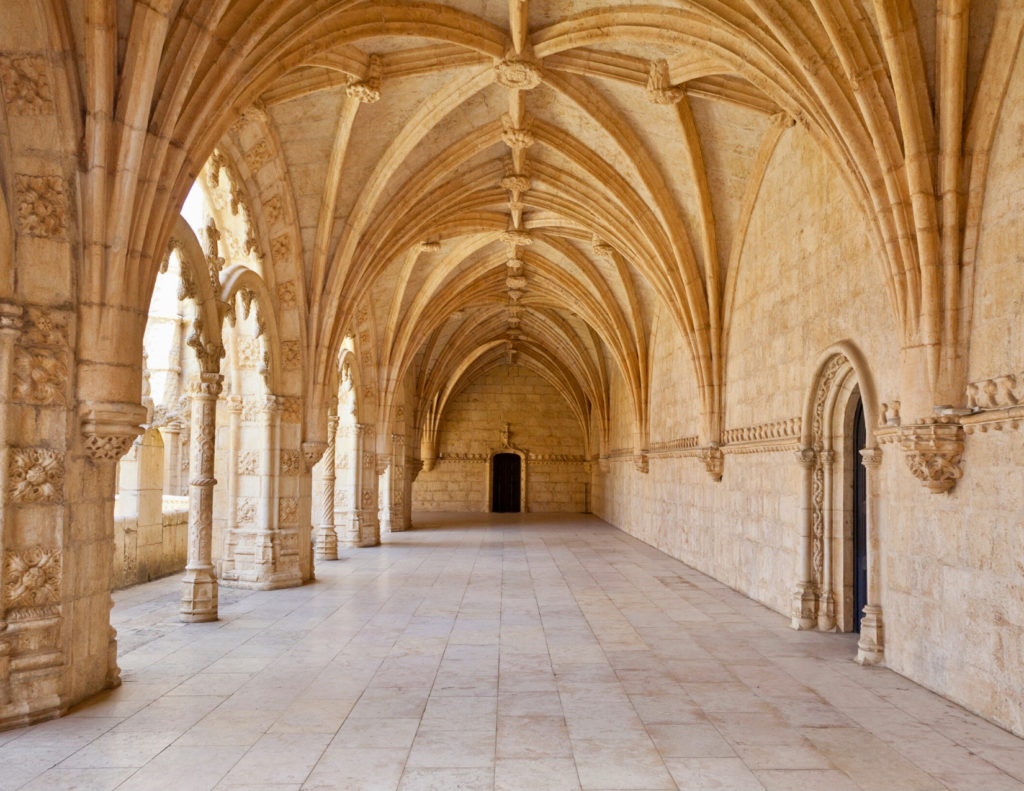
Mini History of Jerónimos Monastery
Manueline architecture was a short-lived late artistic movement that lasted 30 years in the early 16th century.
It’s a unique Portuguese style tied to the glory of old Portugal with Gothic and Moorish influences.
It was named after its key influencer, King Manuel I. Known as the “Lucky King,” he reigned from 1495 to 1521.
Loaded with cash from spice taxes, he built many grand monuments to commemorate Portugal’s marine dominance during the Age of Discoveries.
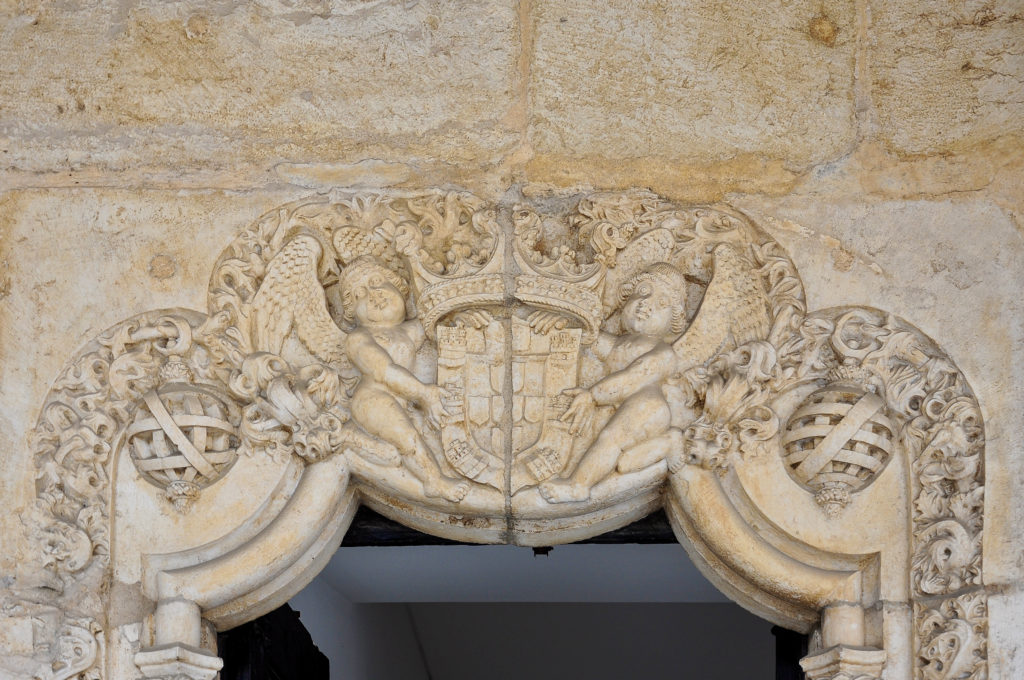
The Manueline style is lavishly and densely ornamental. It’s Flamboyant Gothic on steroids, a restless decoration that covers every surface with ornate decoration.
There’s also the influence of Moorish architecture. That reflects the Moorish conquest of southern Portugal and Spain.
The Manueline style has a significant focus on maritime symbols in its architectural motifs. The only real religious symbol used is the cross. But that’s perhaps because the cross was used on ship flags.
These marine motifs — coral, seaweed, barnacles, ships, ropes, buoys, anchors — were encrusted on facades, columns, and arches. Everywhere really.
Manueline arches aren’t pointy Gothic ones anymore. They’re round and semicircular.
The twisting and curvaceous Manueline style is rooted in nature. It might even be considered a precursor of to the organic architecture of Antoni Gaudi and the Modernist.
Austere stone pillars are twisted with silken cords. There are clouds of leafy stone tracery. Everything spirals and leaps.
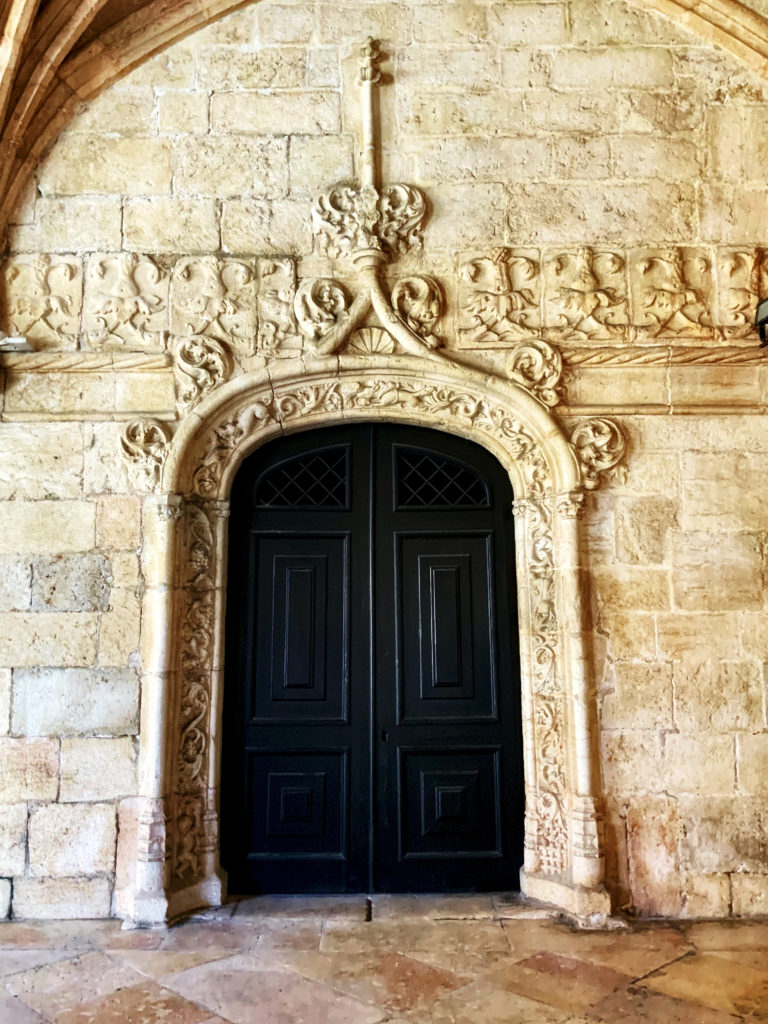
Jeronimos Monastery was funded by spice profits, brought back from India by Vasco de Gamma.
The whole building is a monument, in part, to his daring and successful 1497 sea voyage to India. By touring the monastery, you can get a sense of Portuguese history.
The monastery was designed to trumpet Portugal’s wealth and dominance.
Building began in 1502, under the creative vision of Diogo de Boitac. But it was so ornate that it took nearly 100 years to complete.
Jerónimos Monastery was first populated by Hieronymite monks of the Order of St. Jerome, a relatively small order. St. Jerome was a 5th century scholar who translated the bible into Latin.
The monks’ mission was to comfort sailors and pray for the soul of the lucky king. The church was a place for sailors to attend mass before their dangerous sea voyages.
The order was dissolved in 1833. The monastery was then used as a school and orphanage, until about 1940. I 1983, the monastery became a UNESCO site.
Miraculously, it was one of the only 16th century structures in Lisbon that survived the 1755 great earthquake with only minor damage.
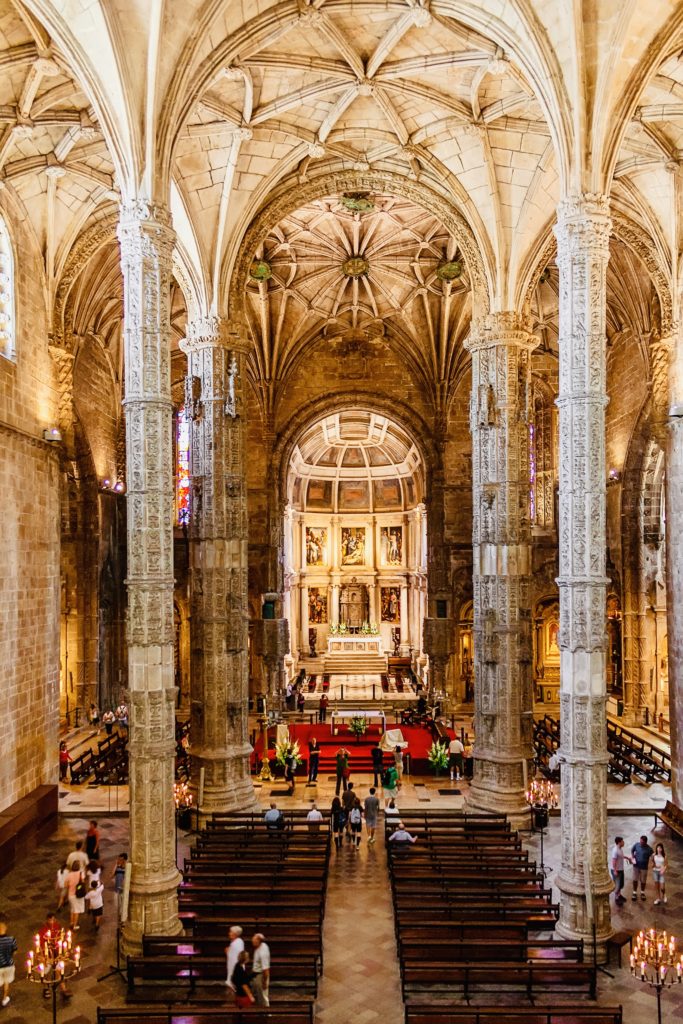
Guide To Jerónimos Monastery: What To See
Church of Santa Maria de Belém
The monastery has an adjoining church. It’s free to visit.
There’s a separate entrance and you should expect a long line.
You’ll be gobsmacked when you enter the church. This is one of the most decorated churches in Portugal.
The modest entry belies the lofty interior. Once inside, six massive tree trunk columns soar and spread wide into the cobwebby ceiling. The ceiling itself is a masterpiece, a fanciful spiderweb of stone.
On each side of the choir, there are 16th and 17th century altars. They’re decorated in the Manueline style with carved wooden sculptures covered in green and gold pigment.
One of the altars features the terracotta figure of Saint Jerome.
Superstar navigator da Gama is interred in the lower chancel, just to the left of the entrance. His tomb is festooned with seafaring symbols.
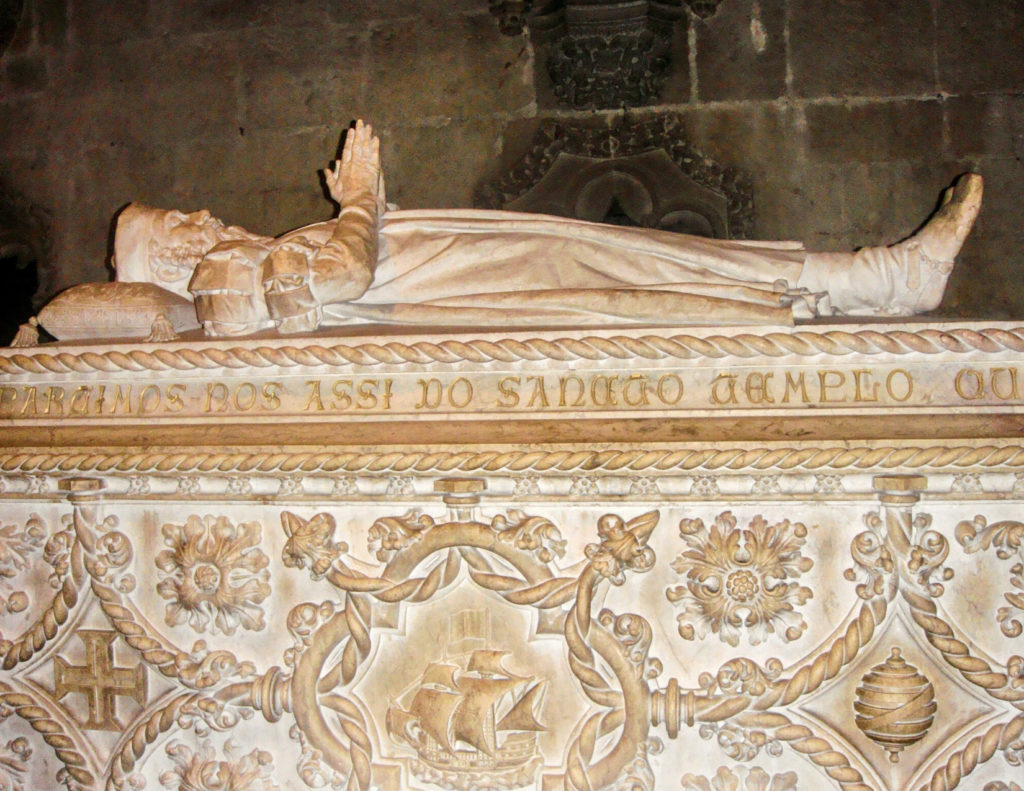
The Cloister Exterior
Built in 1516-18, the south portal on the cloister’s exterior is astonishing. And it’s only a periphery side door.
The portal has filigree-like carvings and 40 statues of saints, scenes from Saint Jerome’s life, 12 apostles, and a central figure of our Lady of Bethlehem. It’s an incredible work of Manueline art.
The west portal bears a regal statue of King Manuel I. It was designed by the French sculptor Nicolau Chanterène in 1517.
Recent testing showed that the portal may originally have been painted.
Cloister Interior
There’s nothing like the moment you walk into the Manueline cloister courtyard, honey colored and dripping with organic detail. It’s breathtaking.
You’ll be wowed by the delicately scalloped arches, twisting turrets, and columns intertwined with leaves, vines, and knots. There are also gargoyles and beasties on the upper facade.
The courtyard is paradise. It’s the most beautiful cloister I’ve ever clapped eyes on.
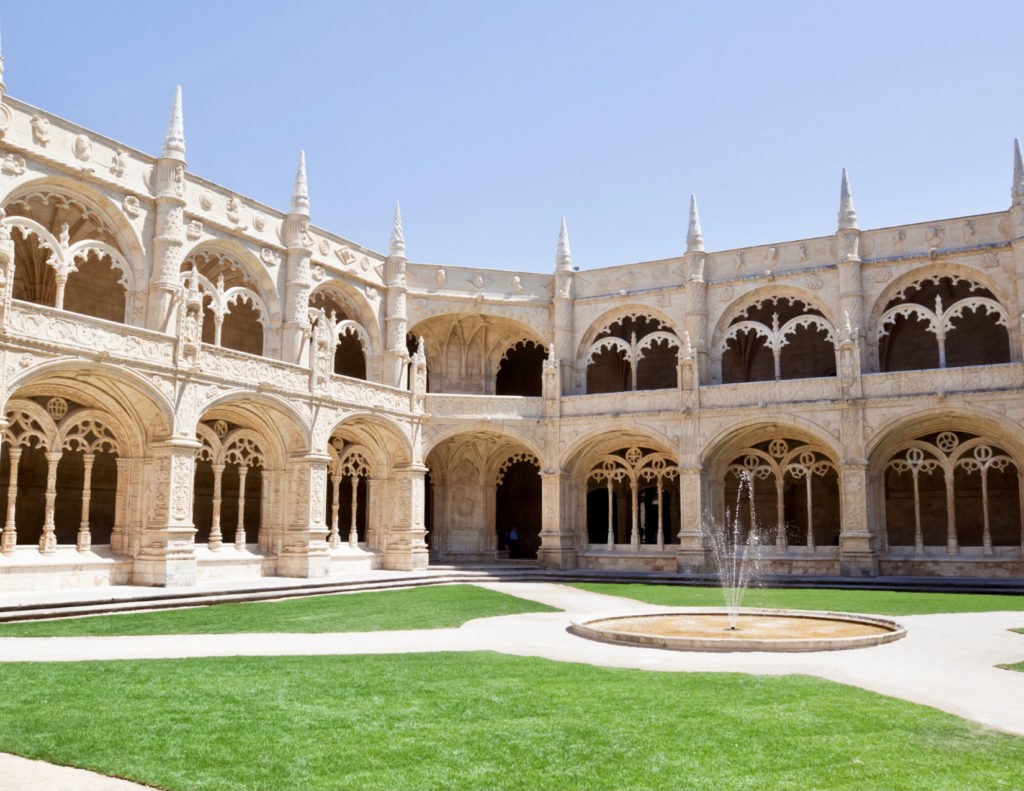
Cloister Courtyard
The cloister was created with limestone from the valley of Alcantara in Spain. There are two levels of cloisters, which was unique at the time.
The top level is less detailed than the bottom level.
Stroll under the vaulted ceilings in the main level, then head upstairs. Admire the elaborate details everywhere. Nothing is the same.
The courtyard is simple. There are no lavish gardens. But you can imagine the contemplative monks coming to bask in the sunshine of the serene place.
After you’re done ogling and admiring the intricate courtyard, head inside.
Refectory
The cloister’s highlight is the Refectory. It’s a vast hall that served as the dining area for the monks.
The Refectory is decorated with beautiful 16th century azulejo panels. They depict scenes from the life of St. Joseph.
Don’t miss the staircase that takes you up to the choir overlooking the church.
Outside the Refectory is the Lion Fountain, which the monks used to wash their hands before meals.
Chapter Room
The Chapter Room was designed as the meeting hall for the monks. However, it was never used for that purpose.
The vaulted ceiling and interior decoration weren’t completed until the 19th century. The Chapter Room holds the tomb of the first mayor of Belém, Alexandre Herculano.
Monks’ Dormitory
The long west wing of the monastery was formerly the monks’ dormitory.
Now, it houses the National Archaeological Museum, founded in 1893. Its Portugal’s main archaeological research center, with artifacts from all over the country.
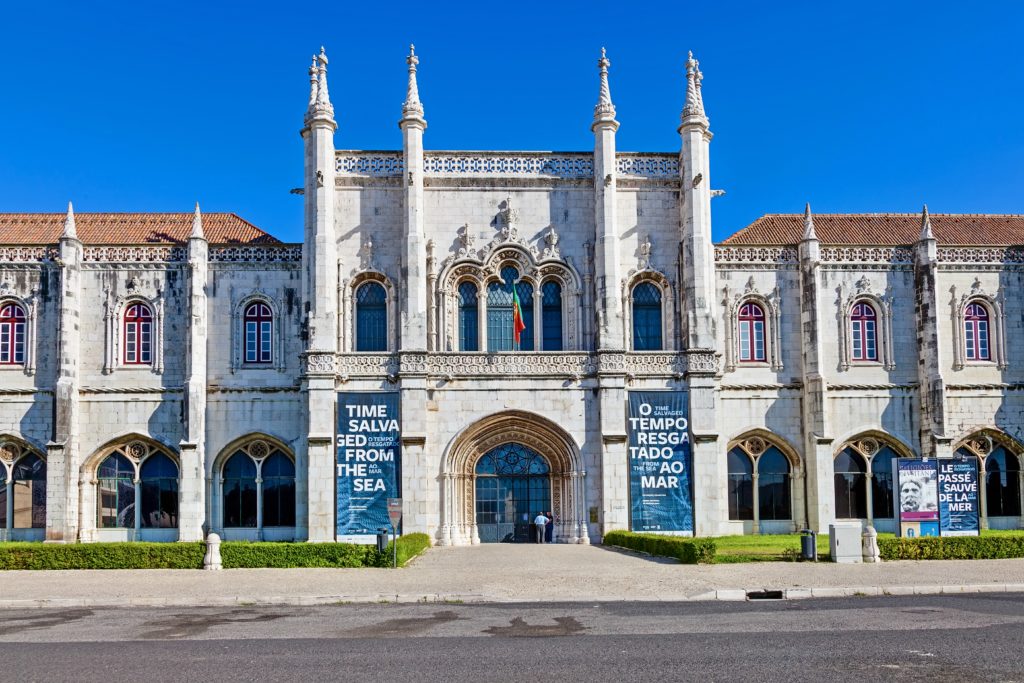
Archaeological And Maritime Museums
In the 19th century “modern” wing of the monastery, you’ll find an archaeology and maritime museum.
The archaeological museum is definitely worth a visit. The must see masterpiece is a Roman statue of Apollo. The Treasure Room has beautiful jewelry from the Bronze, Roman, and Celtic ages.
The maritime museum is where you can learn more about Portugal’s maritime prowess. You’ll see boasts, ship models, navigational instruments, and naval uniforms on display.
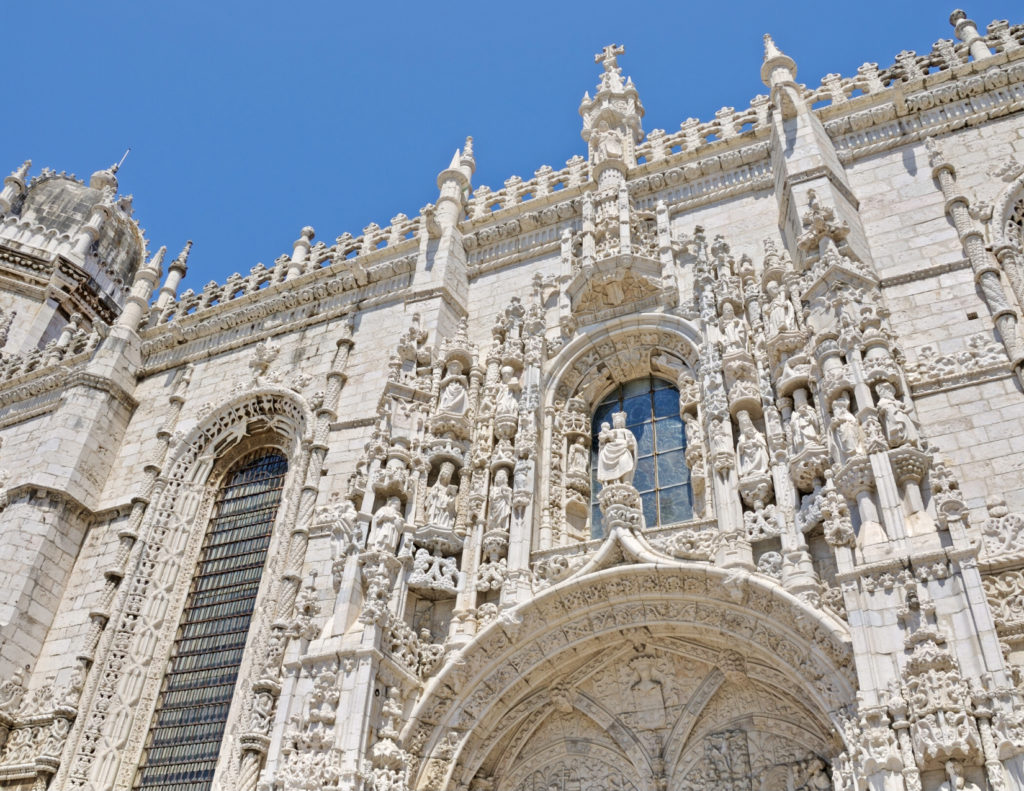
Tips For Visiting Jerónimos Monastery
Jeronimos Monastery can be difficult to visit. It’s just not a well organized attraction.
Along with the regular tourists, cruise and tour groups descend on the complex every day. There’s just one tiny entrance, so you can imagine the chaos in peak season.
1. How To Buy Tickets For Jeronimos Monastery
Jeronimos Monastery has a rather hefty 12 € price tag to enter. But getting a ticket is the real problem.
You can’t buy tickets online from the website, that I could find.
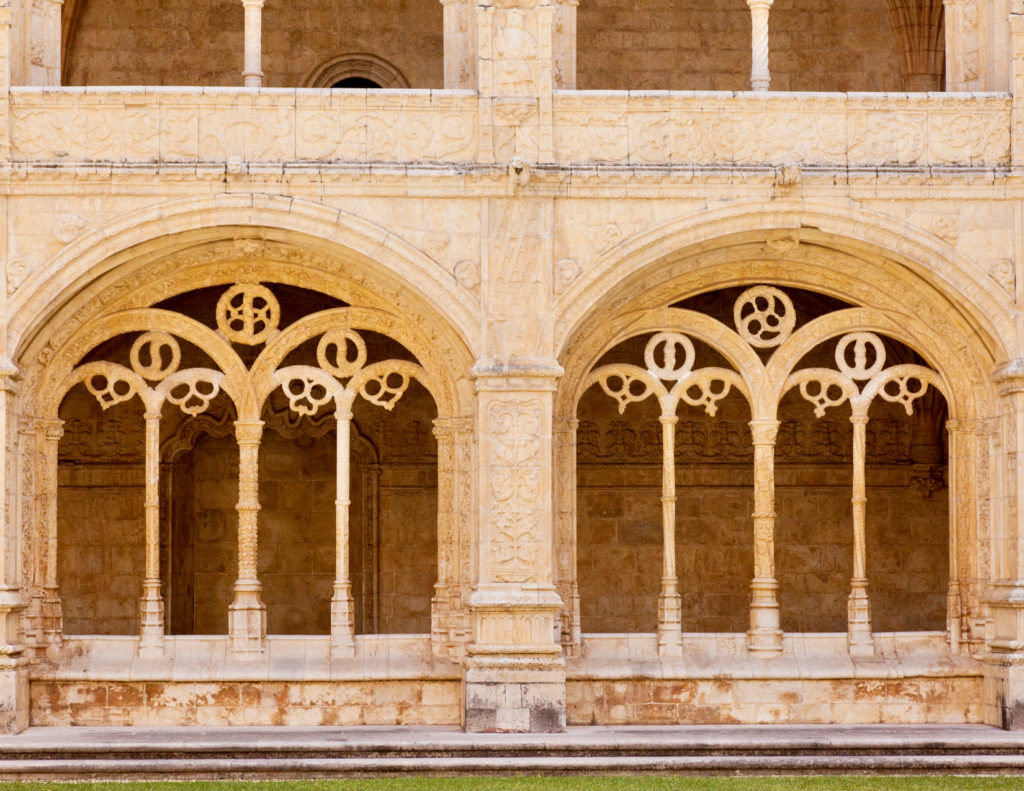
There’s a long queue at the main entrance. At least there was in late April, somewhat to my surprise. I can’t imagine what it would be like in summer.
But don’t be fooled and waste time. There’s actually a separate line for purchasing tickets off to the left of the main entrance. And there’s a huge line there as well.
You purchase tickets via a machine, and some people were befuddled by it. It can all be very time consuming.
If you’re visiting in high season, you may want to skip the interior and just admire the exterior.
But the cloister is so amazing and appealing, it’d be a shame to miss it. It’s mostly worth the tortuous wait.
To speed up the arduous ticket process, my daughter and I split up. She stood in the main entrance line while I stood in the ticket line.
I didn’t know this at the time, but if you’re willing to pay 2 € extra, you can skip one line. Instead of waiting in the monastery’s ticket line, head over to the nearby Archaeological Museum.
There, you can walk right in and buy a combined 14 € ticket for both the museum and the monastery. You have to use a ticket machine.
If I had a do over, I would definitely have used that approach. I also wouldn’t have gone first thing in the morning. (Though that made parking easy.)
Buy far the easiest thing to do is pre-book a skip the line ticket online with Get Your Guide or Tiqets.
I would visit an hour or so before it closes when the day trippers have dispersed and gone back to the historic core of Lisbon.
In sum, to improve your visit:
- buy you ticket at other attractions
- buy your ticket online from Get Your Guide
- arrive late an hour or so before closing
The equally stunning Manueline church is free. There’s a separate line for that too (to the right of the line at the main entrance), but it moved much more quickly.
2. Guided Tours
Another good way to avoid the logjam and get educated at the same time is to book a guided tour.
This 3 hour Belem walking tour gives you skip the line access to the monastery. You can also book a 5 hour Lisbon city tour that includes the monastery.
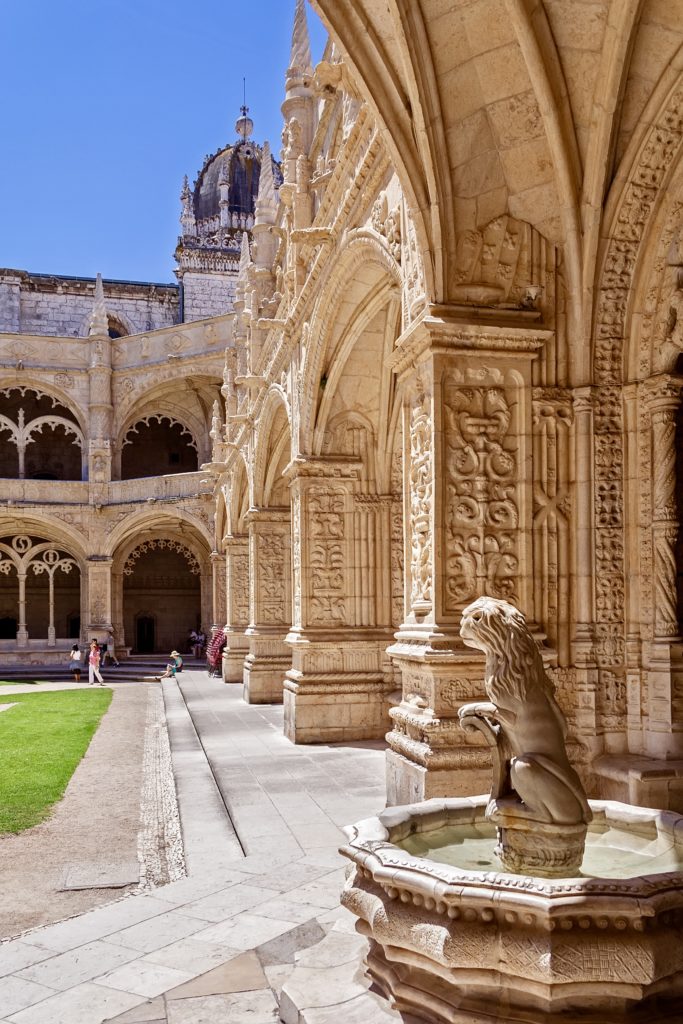
3. Practical Information
Address: Praça do Império 1400-206 Lisboa
Hours: 10:00 am to 6:30 pm Tue-Sun (5:30 pm Oct to May). The first Sunday of the month is free.
Entry fee: 10 €, combined entry with the Archaeological museum is 14 €.
4. How To Get To Jerónimos Monastery
The monastery is about 6 miles from Lisbon. Take Tram #15 from the main Praça square in Baixa. It runs every 10-15 minutes and the ride takes about 25 minutes.
The Hop On Hop Off Bus also goes to Belem, so that is a great option. You can also use the city buses with the numbers 727, 28, 729, 714 or 751. It’s also an easy 10 minute drive.
You can also drive to Belem, which is what I did. There’s a free parking lot in front of the monastery, but it fills up fast so you should plan to arrive early.
I hope you’ve enjoyed my guide to Jeronimos Monastery. You may findthese other Portugal travel guides useful:
- 10 day itinerary for Portugal
- Historic landmarks in Portugal
- 4 day itinerary for Lisbon
- 2 days in Porto itinerary
- 1 day in Coimbra itinerary
- 1 day in Guimaraes itinerary
- Guide to Lisbon’s Alfama neighborhood
- Guide to Lisbon’s Belem neighborhood
- Guide to Pena Palace
- Day trips from Lisbon
- Tips for Visiting Sintra
Pin it for later.

